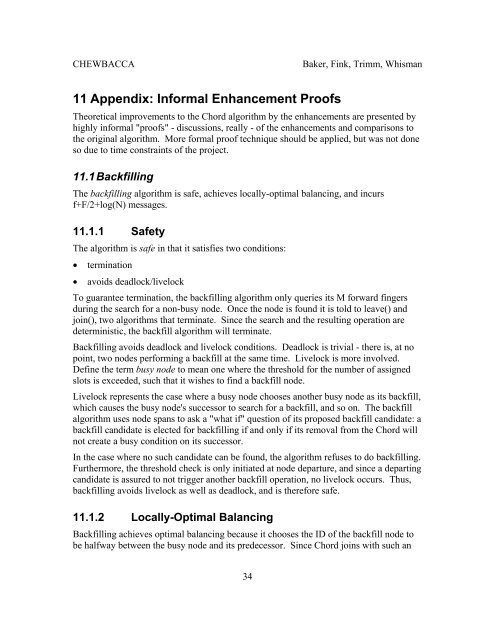Implementing a Distributed Peer to Peer File Sharing System ... - Umbc
Implementing a Distributed Peer to Peer File Sharing System ... - Umbc
Implementing a Distributed Peer to Peer File Sharing System ... - Umbc
You also want an ePaper? Increase the reach of your titles
YUMPU automatically turns print PDFs into web optimized ePapers that Google loves.
CHEWBACCA Baker, Fink, Trimm, Whisman<br />
11 Appendix: Informal Enhancement Proofs<br />
Theoretical improvements <strong>to</strong> the Chord algorithm by the enhancements are presented by<br />
highly informal "proofs" - discussions, really - of the enhancements and comparisons <strong>to</strong><br />
the original algorithm. More formal proof technique should be applied, but was not done<br />
so due <strong>to</strong> time constraints of the project.<br />
11.1 Backfilling<br />
The backfilling algorithm is safe, achieves locally-optimal balancing, and incurs<br />
f+F/2+log(N) messages.<br />
11.1.1 Safety<br />
The algorithm is safe in that it satisfies two conditions:<br />
• termination<br />
• avoids deadlock/livelock<br />
To guarantee termination, the backfilling algorithm only queries its M forward fingers<br />
during the search for a non-busy node. Once the node is found it is <strong>to</strong>ld <strong>to</strong> leave() and<br />
join(), two algorithms that terminate. Since the search and the resulting operation are<br />
deterministic, the backfill algorithm will terminate.<br />
Backfilling avoids deadlock and livelock conditions. Deadlock is trivial - there is, at no<br />
point, two nodes performing a backfill at the same time. Livelock is more involved.<br />
Define the term busy node <strong>to</strong> mean one where the threshold for the number of assigned<br />
slots is exceeded, such that it wishes <strong>to</strong> find a backfill node.<br />
Livelock represents the case where a busy node chooses another busy node as its backfill,<br />
which causes the busy node's successor <strong>to</strong> search for a backfill, and so on. The backfill<br />
algorithm uses node spans <strong>to</strong> ask a "what if" question of its proposed backfill candidate: a<br />
backfill candidate is elected for backfilling if and only if its removal from the Chord will<br />
not create a busy condition on its successor.<br />
In the case where no such candidate can be found, the algorithm refuses <strong>to</strong> do backfilling.<br />
Furthermore, the threshold check is only initiated at node departure, and since a departing<br />
candidate is assured <strong>to</strong> not trigger another backfill operation, no livelock occurs. Thus,<br />
backfilling avoids livelock as well as deadlock, and is therefore safe.<br />
11.1.2 Locally-Optimal Balancing<br />
Backfilling achieves optimal balancing because it chooses the ID of the backfill node <strong>to</strong><br />
be halfway between the busy node and its predecessor. Since Chord joins with such an<br />
34











